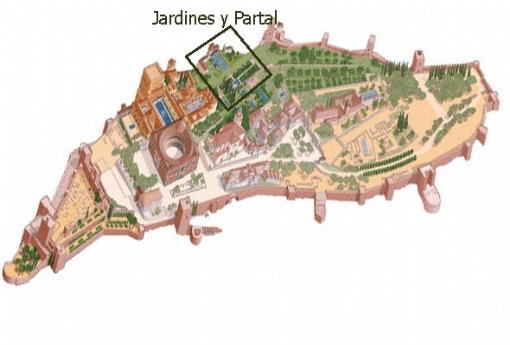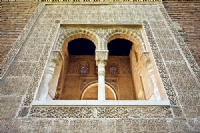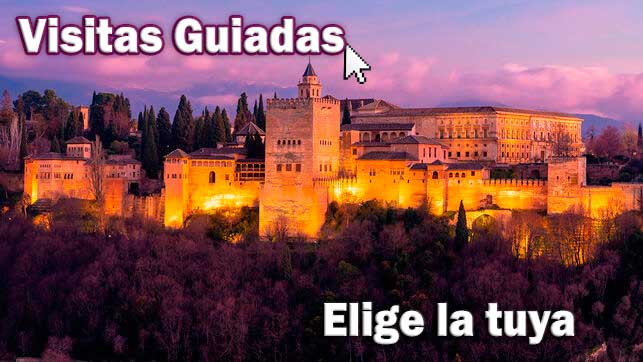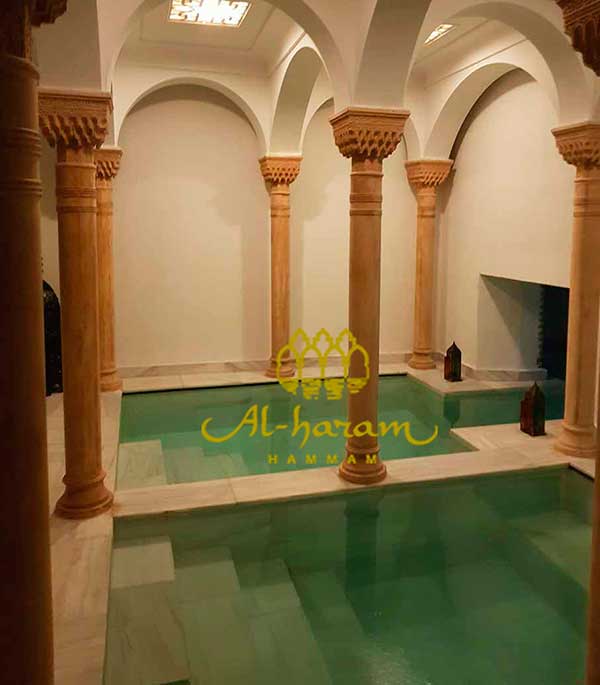- Home
- Guide Alhambra
- Main Areas Alhambra
- Palace and Gardens

Partal Gardens
These gardens extend from the exit of the Rauda to the esplanade where the Torre de las Damas is located. In this same place were the gardens that surrounded the royal palaces, also distributed in a staggered manner and that, later, occupied the rooms of Emperor Charles V.
During the Arab period it housed numerous buildings of magnates who lived around the Royal Palace, of which the Torre de las Damas stands out for its importance. The Jardines del Partal are an incredible place to stroll or stop during your visit to the Alhambra in Granada.
Of the old palaces that existed in this area, only the Palace of the Portico has reached us, partially, of which the Tower of the Ladies is preserved. Probably from the times of Muhammad III, we are in front of the oldest palatial building of those preserved in the Alhambra, which suggests that the first Nasrid kings established their residence in this area. This palace stands on the wall, and is made up of a square room, inside the Tower of the Ladies, a portico with five arches facing a large pond and a small viewpoint over the building.
To the left of this building we can see three small Arab houses, built after the palace, and that keep in their interior Arab paintings of great value; they are not visitable. To the right of the pond we find the Torre del Mihrab, which preserves a small oratory decorated in the time of Yusuf I.
Going up through the gardens we can find, to the right, a tower or Qubba, called the Torre de la Rauda, which communicates with the Palace of the Lions, and which has an interesting vault inside. Next to it we can find the remains of the Royal Cemetery or Rauda, from which the tower takes its name.
Returning to the gardens, we can see the remains of several palaces, since the Muslim nobility lived in this area. The most important of them was the Palace of Yusuf III or the Counts of Tendilla, similar in plan to the Palace of Comares. Sadly demolished in the 18th century, it is said to be one of the most sumptuous in the Alhambra. From here the visit continues along the Paseo de las Torres.
Tower of the Ladies
It is the most important of the buildings of magnates who lived around the Royal Palace in Arab times and its decoration the oldest in the Alhambra. It has been known by multiple names, depending on the inhabitant who occupied it at all times, although since the end of the s. XVIII took its current name. At first the building was called "Partal" (portico) by which its five arches formed, which are reflected in the rectangular pool between them.
Until 1924, the year in which its restoration was completed, it underwent numerous reforms by its various occupants to adapt it as a dwelling. It consists of the portico, a square room, and a staircase that gives access to a later-built viewpoint, from which you can see the valley of the Darro. The five arches of the portico, of which only the central one is preserved, are supported by marble columns, although before they were by brick pillars.
To the left of this tower are three small Arab houses, built after the tower and attached to it. In one of them some paintings were discovered that, although deteriorated and incomplete, are the only ones of this type in Muslim Spain. Made in the first half of the s. XIV, represent hunting scenes, fantastic animals, men and women.
Oratory of the Partal
This is a small oratory, inside a tower, facing Mecca, to the east. It was also called Mihrab because it had a mihrab. According to the Arabs, Mihrab was the part inhabited by the spirit of God or the place of prayer ordered by the prophet. They returned his body to the east to look at the place where the holy books were kept.
In this place the Santón waited for the sunrise reciting the prayers. He had the essential rooms to lead his life. We can observe in more detail the entrance to the oratory, and the window that we see on its south side. This tower is very restored and changed. In it lived a squire of the count of Tendilla, governor of the Alhambra, called Astase de Bracamonte.
The harem
The Harem was an exclusively feminine space. An extraordinary viewpoint, open to the patio by three arches, which in its time would have a lattice, allowed the contemplation of the concubines of the same without originals in this room, with an extraordinary carving.
Contrary to what is popularly thought to be a Harem, this is nothing more than the home of the president, where there are no official receptions, or protocol, in short, where the monarch developed his family life within the palace, far from the idea that the Harem was where the sultan kept his wives away from the rest of the world, constantly watched over by a court of eunuchs, and where only the sultan was allowed access. Quite the contrary, tradition says that one day Muhammad was playing with his grandchildren, but the prophet received visits from friends and faithful very often and without prior notice. So that day a group of faithful came to visit him without warning and pulled back the curtain behind which Muhammad was rolling on the ground with the children. It seems that surprising the great teacher in that attitude was not to the liking of either the prophet or his disciples, so after that incident, Muhammad began to speak to his followers that it was necessary to enable a part of the house for use exclusive to the family, where entry to visitors was prohibited.
Casitas del Partal

This is the name given to the group of houses built in the 14th century, following the portico of the Partal palace, also mounted on the wall.
The four Casas del Partal - the González Pareja house, the Villoslada house, the Balcones house and the Pinturas house - are independent, all have two floors and lack a patio. Its main attraction is that they keep in their interior remains of plasterwork ornaments, a beautiful armor and especially some courtly-type wall paintings. According to some authors, they constitute the only example in the Monumental Ensemble of Nasrid painting, since the paintings in the Sala de los Reyes in the Patio de los Leones were made by Christian painters.
Do you have any doubt? Call us
+34 958 91 80 29 From Monday to Friday 9.00 - 14.00 and 17.00 - 20.00Other Recommended Services
Choose your service




